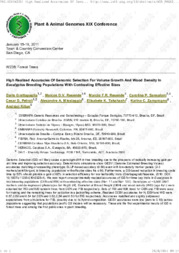High realized accuracies of genomic selection for volume growth and wood density in Eucalyptus breeding populations with contrasting effective sizes.
High realized accuracies of genomic selection for volume growth and wood density in Eucalyptus breeding populations with contrasting effective sizes.
Autoria: GRATTAPAGLIA, D.; RESENDE, M. D. V. de; RESENDE, M. F. R.; SANSALONI, C. P.; PETROLI, C. D.; MISSIAGGIA, A. A.; TAKAHASHI, E. K.; ZAMPROGNO, K. C.; KILIAN, A.
Resumo: Genomic Selection (GS) will likely cause a paradigm shift in tree breeding due to the prospects of radically increasing gain per unit time and improving selection accuracy. Deterministic simulations show GEBV (Genome Estimated Breeding Values) accuracies matching or exceeding phenotypic BLUP-based-accuracy (0.68) even with low-density marker panels (2-3 markers/centiMorgan) in breeding populations with effective sizes Ne ? 60. Furthermore, a GS-based reduction in breeding cycle time by 50% should provide a gain ?100% in selection efficiency for low heritability traits (Grattapaglia&Resende, 2010; DOI: 10.1007/s11295-010-0328-4). We now report on experimentally realized accuracies of GS for three key traits in Eucalyptus in two breeding populations (CEN and FIB) with contrasting effective sizes (Ne= 11 and Ne= 120). Genotypes at ~3,500 DArT markers and de-regressed phenotypes for Height (H), Diameter at Breast Height (DBH) and wood density (WD) (age 4yr.) were obtained for 783 and 920 random trees from CEN and FIB respectively. Sets of 700 and 838 trees for CEN and FIB were used for training and the remaining trees for validation in a jackknifing scheme. Realized GEBV accuracies for H, DBH and WD were 0.67,0.69 and 0.54 for CEN and 0.62,0.54 and 0.53 for FIB respectively. Accuracies matched and slightly surpassed expectations from simulations for FIB, possibly due to its hybrid composition. GEBV accuracies were low (zero to 0.18) across populations suggesting that population specific GS models will be necessary. These are the first experimental results of GS in forest trees and among the first public ones in plant breeding.
Ano de publicação: 2011
Tipo de publicação: Anais e Proceedings de eventos (considerados no todo)
Palavras-chave: Eucalyptus, Melhoramento genético, Seleção genômica
Observações
1 - Por padrão são exibidas publicações dos últimos 20 anos. Para encontrar publicações mais antigas, configure o filtro ano de publicação, colocando o ano a partir do qual você deseja encontrar publicações. O filtro está na coluna da esquerda na busca acima.
2 - Para ler algumas publicações da Embrapa (apenas as que estão em formato ePub), é necessário ter, no celular ou computador, um desses softwares gratuitos. Sistemas Android: Google Play Livros; IOS: iBooks; Windows e Linux: software Calibre.
Acesse outras publicações
Acesse a Base de Dados da Pesquisa Agropecuária (BDPA) para consultar o acervo completo das bibliotecas da Embrapa.

